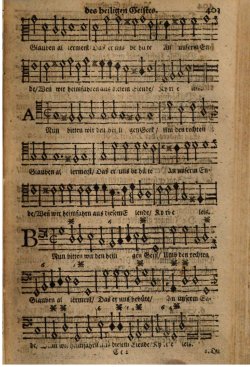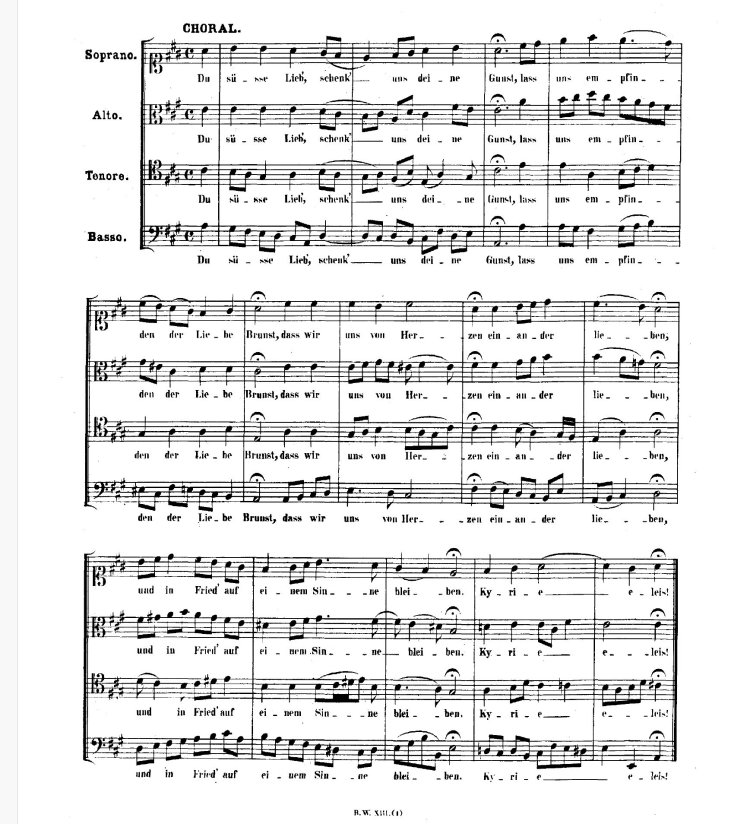|
Chorale Melodies used in Bach's Vocal Works
Nun bitten wir den heiligen Geist |
|
Melody & Text | Use of the CM by Bach | Use of the CM by other composers |
| |
|
Melody & Text: |
|
"Nun bitten wir den Heiligen Geist" (We now implore the Holy Ghost) is a German Christian hymn. The first stanza dates from the 13th century and alludes to the Latin sequence Veni Sancte Spiritus. The most prominent form of the hymn has three more stanzas written by the Protestant reformer Martin Luther. His version appeared first in 1524 in Wittenberg as part of the choral hymnal Eyn geystlich Gesangk Buchleyn. The Holy Spirit is addressed, which makes the song suitable for Pentecost. General themes of faith, love and hope make it appropriate for general occasions and funerals as well.
The chorale is part of many hymnals, sung in several Christian denominations and in translations. It inspired vocal and organ music from the Renaissance to contemporary, including composers such as Michael Praetorius, Dietrich Buxtehude and J.S. Bach. Alternate versions of the hymn, concluding the same medieval first stanza have appeared in Catholic hymnals.
The first stanza is documented in the 13th century: the Franciscan Berthold von Regensburg (died 1272) quoted it in a sermon.
Nû biten wir den heiligen geist
umbe den rechten glouben allermeist,
daz er uns behüete an unsrem ende,
sô wir heim suln varn ûz disem ellende.
kyrieleis.
It is a prayer in German to the Holy Spirit, reminiscent of the Latin sequence Veni Sancte Spiritus. The concern is "most of all" (allermeist) the "right faith" (rechten glouben), considering to return "home" (heim) after the "exile" (ellende) of life. In the old German (Middle High German), "ellende" meant exile and was stressed on the second syllable, rhyming with "ende", whereas the modern "Elend" is stressed on the first syllable and translates to "misery".
A tune derived from the chant of the sequence appeared first in Jistebnitz around 1420.
The reformer Martin Luther intended this stanza to be sung every Sunday between the readings of the epistle and the gospel. In 1524, M. Luther continued the prayer in three additional stanzas, addressing the Holy Spirit three more times, as "Du wertes Licht" (You esteemed light), "Du süße Lieb" (You sweet love) and "Du höchster Tröster" (You highest comforter). The hymn is a "Leise", concluding each stanza by "Kyrieleis". The three added stanzas can be as seen related to Paul's concept of "Glaube, Liebe, Hoffnung" (faith, love, hope), which he expressed in his First Epistle to the Corinthians, 1 Corinthians 13:13.
M. Luther's text, set to music by Johann Walter, appeared in 1524 in Wittenberg. It was part of J. Walter's choral hymnal Eyn geystlich Gesangk Buchleyn. Johann Crüger included it, as many of M. Luther 's songs, in his hymnal Praxis pietatis melica which was first published in 1647. The hymn has often been associated with Pentecost. It is part of many hymnals, in several Christian denominations and in translations. The oldest translation to Danish appeared in 1528. Translations to English include "We now implore God the Holy Ghost" in The Lutheran Hymnal (St. Louis, 1941).
Michael Vehe, a Dominican monk and theologian, took in 1537 the medieval stanza as a starting point which he completed by adding three different stanzas. His version appears with the chant melody in the first German Catholic hymnal Gotteslob as GL 870 for the Diocese of Limburg. In the main section of that hymnal, it appeared as GL 248 again in a different version, with stanzas two to four written in 1972 by Maria Luise Thurmair, who closed with a fifth stanza modeled after Vehe's second. The melody is a transcription of the chant in fixed rhythm. This version was kept in the second edition of the Gotteslob, GL 348.
Source: Wikipedia (May 19, 2018) |
|
Cantata BWV 169 closes with an emphasis on the Second Commandment to love one's neighbor, as found in the third verse of M. Luther's 1524 "Nun bitten wir den Heiligen Geist" (Now Let Us Pray to the Holy Spirit): "Du süße Liebe, schenk uns deine Gunst" (You sweet love, grant us your favour). M. Luthers four-stanza Gradual Song between the Epistle and Gospel lessons in the main service is found as a designated <de tempore> Pentecost Hymn in the NLGB No. 130.
J.S. Bach did three harmonized settings (all in A Major) of M. Luther's contrafaction of the Latin sequence, Veni, sancte spirtus. Besides the closing simple setting of Stanza 3 in Cantata BWV 169/7, J.S. Bach also elaborately set Stanza 3 to close Part 1 of the 1736/7 wedding parody Cantata BWV 197, "Gott its unsre Zuversicht" (God Is Our Trust), as well as the untexted setting, BWV 385, that dates to c1730 on stylistic grounds and may have been performed at a Pentecost service. In addition, Piacander's 1728 cantata annual cycle text for the 18th Sunday after Trinity (September 26), "Ich liebe Gott vor allen Dinge" (I Love God Before All Things), also uses Stanza 3 but J.S. Bach did not set the libretto. J.S. Bach also designated M. Luthers hymn as a Pentecost service chorale prelude in his Weimar Orgelbüchlein (Little Organ Book), No. OB 45, but did not set it.
Source: Motets & Chorales for 18th Sunday after Trinity (William L. Hoffman, April 29, 2012) |
|
Melody: Zahn 2029
Composer: Johann Walter (Wittenberg, 1524), based on 13th century melody |
 |
|
Text: Nun bitten wir den heiligen Geist (NLGB 130; EG 124)
Author: verse 1: Berthold von Regensburg (13th century); verses 2-4: Martin Luther (Johann Walter Gesangbuch, 1524) |
|
Hymnal versions Bach may have known: |
|


|
|
Text of Nun bitten wir den Heiligen Geist in Wittenbergisches Gesangbuch 1524 | Text of Nun bitten wir den Heiligen Geist in the 1653 edition of Johann Crüger's Praxis pietatis melica |
|



|
|
Melody & text of Das walt’ mein Gott, Vater, Sohn und heiliger Geist (NLGB ) from the Neu Leipziger Gesangbuch, pp 402-404 |
| |
| |
|
Use of the Chorale Melody by Bach: |
|
Text: Nun bitten wir den heiligen Geist |
|
Chorale Du süße lieb, schenk uns deine Gunst (Mvt. 7) from Cantata BWV 169 (1726 (verse 3) |
 |
|
Chorale Du süße lieb, schenk uns deine Gunst (Mvt. 5) from Cantata BWV 197 (1736-1737) (verse 3) |
 |
|
Chorale Nun bitten wir den heiligen Geist, BWV 385
Ref: RE 36; Breitkopf 36; KE 385; Birnstiel 40; Dietel 109; AmB 46II p.310; Levy–Mendelssohn 22; Fasch p.80; BGA 132; BC F147.1; CST 262-264 |
 |
| |
| |
|
Use of the Chorale Melody by other composers: |
|
Johann Walter, who collaborated with M. Luther, modified the medieval chant tune slightly and set it for four for his Eyn geystlich Gesangk Buchleyn.
Michael Praetorius composed seven a cappella settings, for two to six voices. Dietrich Buxtehude composed two organ preludes, BuxWV 208 and BuxWV 209.
Organ preludes were composed by Georg Böhm, Helmut Eder, Paul Hamburger, Arnold Ludwig Mendelssohn, Ernst Pepping, Heinrich Scheidemann, Heinrich Scheidemann, Johann Gottfried Vierling, Helmut Walcha and Johann Gottfried Walther, among others.
Johann Nepomuk David wrote in 1936 a Choralmottete (chorale motet) for four-part choir a cappella Nun bitten wir den Heiligen Geist. It is the first movement of Ernst Pepping's Deutsche Choralmesse (Chorale Mass in German) for six voices a cappella (SSATBB), in the position of the call Kyrie of the Latin mass.
Herbert Blendinger composed in 1984 for cello and organ Meditation über den Choral "Nun bitten wir den heiligen Geist", Op. 36. Jacques Wildberger composed Diaphanie: per viola sola: fantasia su per "Veni creator spiritus" et canones diversi super "Nun bitten wir den heiligen Geist", published in Zürich in 1989. |
| |
| |
|
Sources: Bach Digital; BGA; Zahn; BCML discussions on BCW; Charles Sanford Terry's Bach Chorals books
Photos from Gottfried Vopelius: Neu Leipziger Gesangbuch (Vopelius 1682) & Christian Friedrich Witt: Psalmodia Sacra, Oder: Andächtige und schöne Gesänge… (Gotha Hymnal, 1715), were taken from digital copies of the books downloaded from Bayerische Staatsbibliothek München. These copies are Out of copyright - non commercial re-use (Europeana Rights).
Prepared by Aryeh Oron (October 2018) |